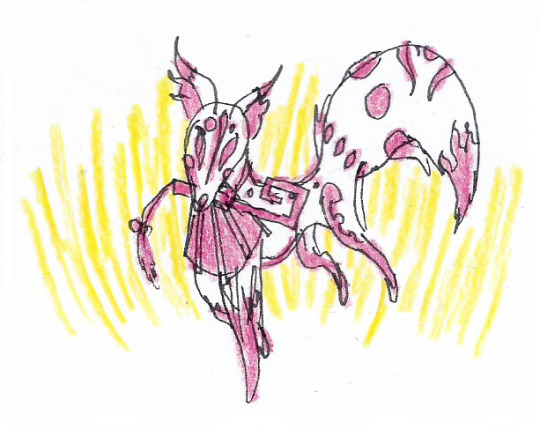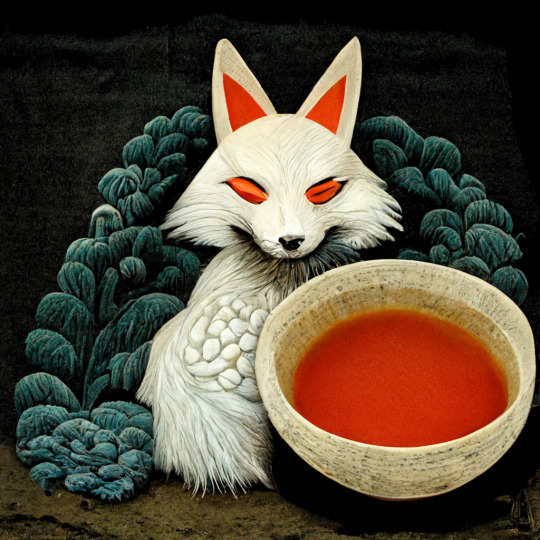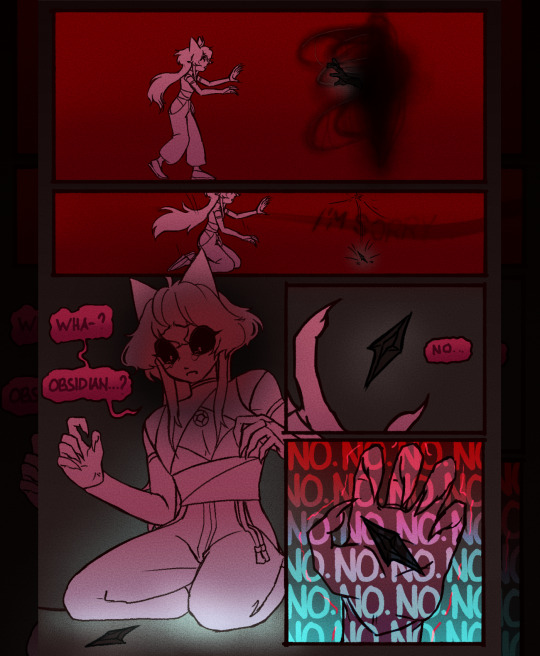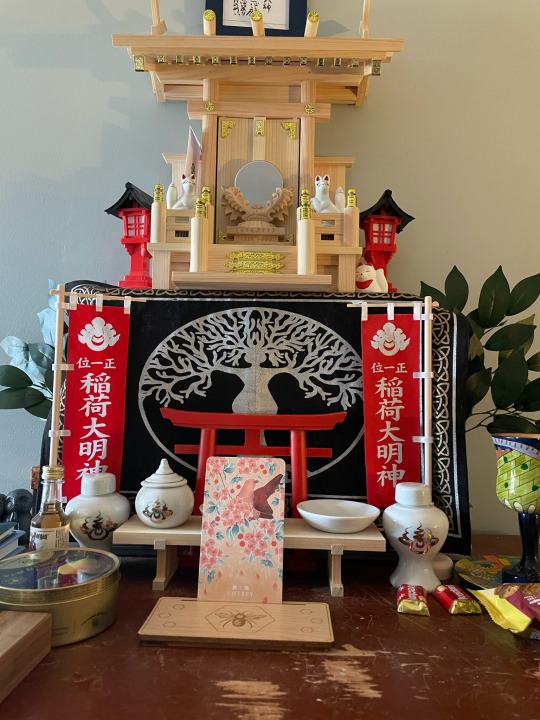#Inari Okami
Text

Inari Ookami!
Commission info
#shinto#inari okami#japanese mythology#art by op#my art#artists on tumblr#I ignored conventions regarding how they're depicted and just did what felt like#every once in a while I gotta to do detailed stuff
46 notes
·
View notes
Text
Rambling About Inari Okami, foxes and a bit of Shinto.


Kazuma Kaneko's Inari: Ukamo Mitama, and the Fushimi Inari Temple in Kyoto, picture taken by my best friend!
Hey, this was not planned to be a post of my Compendium Entries series, and it will not be. As a friend of mine who is a designer started a work with the Inari as inspiration, and my best friend visited a shrine in Japan, i got curious and studied this deity a bit, and wanted an excuse to ramble about it! Still, it was not enough research to enter the Compendium, and also i think i have spent a lot of time in Asia in this series. So, while we are moving from the continent, let's add Inari as a side note, because it is such an interesting kami!
But as always... Don't make me tap the sign...
Warning: Faith and religion are important real life topics, that tackles the culture and way of life of millions of real life people. It is a cultural expression, and must be respected by all means. Here, we use a video-game series only to ignite the flame of learning about the matter, using its art when well depicted, but we do this with all due respect to the cultures we talk here, grounded by real life sources, cultures and people. And i mean this with respect. Hope you all enjoy.
The Identity of the Inari
On contrary on what many could think, Inari is not a name associated to one god. But rather, it is like a title to many kami! Inari is not necessarily a fox entity as well! But their true identity ca be a bit complex. But what do end up in every interpretation, is that Inari is related to prosperity, fertility and food.
What really gets me is that... Inari is not one Kami, but rather many!
Since it will vary depending on what time, place and culture you are inserted in, Inari has many faces. According to the book ''The Rice Goddess and Fox In Japanese Religion and Folk Pratice'' There is a version of the tale that tells about a time o great hunger in ancient Japan, when Inari descent from the heavens mounting a big white fox. She brought forth the grains capable to grow in the swampy soil at the time, and so that saved Japan.
I could not find more about this version, only that it is being parroted over the internet for a while, but let's give the benefit of doubt here because you know... language barriers.
The name Inari was originally written in many forms, and with many meanings. According to the Fushimi Inari Taisha temple (more on that later) there are many examples like that, like for example the Inari being mentioned in the Ymashirokoku Fudoki, a cultural report on Japanese provinces finished in the year 713. The most modern way to write and the meaning of Inari, seemed to have originated in the year 827. [1]
The Cultural Alliance Brazil-Japan (A government organization focused in cultural exchange between both countries) says that Inari has many interpretations. And indeed, if there's a thing you notice researching the Inari, is that theres no consensus on its interpretation.
They mention some interpretations like an old man with beard with two white foxes, or a woman with two bags of rice riding a big white fox. But they are also frequently associated and confused with the foxes that adorn their shrines.
The Inari are very popular in Japan! It has a large variety of temples and shrines, being revered by people and organizations that pray for prosperity. The main Inari shrine is located in Kyoto, the Fushini Inari temple. It's main features are the thousands of Tori, and fox statues.
Thankfully they have an English site for you to visit and read about this temple. A neat thing that i learned is that this temple was built in the year 711, which means it is more than 1300 years old! That's older than anything in my home country! my best friend was there, and took some great pictures!

Inside the thousands of Tori in the Fushimi Inari Taisha temple! Picture by my friend!
According to the temple's site, there are shrines to the Kami: UIkanomitama, Satahiko, Omiyanome, Tanaka no Okami, and Shino Okami in the Fushimi Inari. They are all Kami going by the Inari title, and being revered as such.
In my researches i got the name Ukanomitama quite often! You will also see them a lot, because it is one of the most associated Kami with the Inari. Ukanomitama has two origins, as long as i could find:
The first came from the Japanese ancient book of the Nihongi, written in the year 697 is one of the oldest Japanese written works, and still is of immense cultural importance to the Japanese culture. Some famous Kami and Yokai came from there!
But Ukanomitama also did. In this book, in only one verse, it narrates how it was born from Izanagi and Izanami's hunger. You can read the entirety of the work, or some parts translated to English here:
Link to the Nihongi
The other source for Ukanomitama cames from the book Kaijiki, which is also more or less from this period of time. Around the 8th and 7th century. In this version, the change is that this Kami was born from Susanoo.
Either way, Ukanomitama ended up associated as a food Kami, an entity to end hunger, which made it considered an Inari, being even enshrined in the main Inari temple.
To go deep into the Inari identity, i came forth to the famous site Living With Kami, which belongs to a Shinto Pristress and Professor on the topic! Luckily she had a few articles to talk about Inari, which is no surprise due to the Inari's popularity.
(This site is pretty awesome, with tons of amazing knowledge about Shinto. You should take a look if that interests you!)
According to the Pristress, theres not ONE Inari no Okami, but as we discussed before, that's kinda like a title. Therefore, all Kami enshrined at Fushimi Inari, for example, are Inari no Okami. This includes our friend Ukanomitama!
Still according to her, Inari are, in some times and places, associated as a shapeshifter entity, possessing no defined gender or physical appearance.
Theres no definitive answer on this matter, and will depends on the person you ask, their fate, their culture, their place, etc... So, Inari is pretty much a group of Kami.
In Takkekoma Inari, the second biggest and oldest temple dedicated to the Inari, other two Kami are enshrined: Ukemochi and Wakumusubi.
The foxes, the red and the devils

Another great picture from my friend!
For us westerns, and in pop culture, The Inari are almost always associated to foxes, and even became foxes some times. But still according to the Fushimi Inari temple, the Inari are not necessarily taking the form of a fox, but rather they are affiliated with the foxes. They symbolize the Inari and act as their messengers, that's why people pray to the foxes and give offerings to them.
They could be Kitsune, which are a relative term to supernatural foxes, not only a Yokai, but there is also no consensus on this either. They are not regular foxes, that's for sure.
They are time to time confused with generic Kitsunes or the Inari themselves, its normal that it all became mixed. Specially because of the worldwide popularity of this Kami.
For my personal interpretation, since Kitsunes are supernatural foxes, and the Inari foxes are supernatural, (I know, that's not a very good explanation) i believe every Inari fox is a Kitsune, but not every kitsune could be a Inari fox.
There's a fun trivia about the Inari foxes and food, which is fitting: again according to the Japan-Brazil Cultural Alliance, the offerings to the Inari foxes are usually Abura Age, some type of beans dish. That's said to be the foxes favorite food! So much so, that there is a type of Sushi made using Abura Age, called Inarizushi!
The Japan-Brazilian association of earlier, also talks about a theory that foxes are associated with rice, due to their apparitions in rice fields during harvest seasons. This is debatable inside folkloric studies of Japan.
The other thing that is very much associated with the Inari, is the red cloths that they are usually wearing, most commonly on statues, but some times they have red details in their bodies as well. The red details can be seen on the fox masks people usually wears during festivals.
But why the color red? What does it mean, and where it came from?
The red cloth they wear often is interpreted starting as people putting it on Inari foxes statues to ask protection for their families. Accoring to the Fushimi Inari Taisha, quoting them directly:
''Vermilion red is considered an amulet against evil forces, and is used in many ancient palaces, shrines and temples. At Fushimi Inari Taisha, it is described as a color that expresses bountiful harvests that Inari Okami gives us, but vermilion red is used for many other shrines too.
The pigment used for vermilion red buildings like this is made from mercury and red earth. This mixture has been used to preserve wood since ancient times.'' -FAQ Fushimi Inari Taisha.
According to Onmarkproductions (a pretty amazing website that works as a dictionary for buddhist and shinto faith) Red has been associated with specifically the Kami of Smallpox Hosokami. (疱瘡神) Small pox has been first recorded in Japan in the Nikon Shoki (日本書紀). This was around the year 720 A.D. It is thought that the disease reached Japan much earlier, at the year 550. As many of you already know, it was a very deadly disease and it inspired fear in many.
The Japanese started recommending that children with Smallpox were to be clothed in red clothing, as the ones carrying the sick as well.
Still at this source, many Japanese folk beliefs regarded Red as a color for ''expelling demons and illness.'' For example, the rituals of spirit quelling taken by the Yamato court during the Asuka period (522-645 AD), were mostly centered around the Fire God (a red deity).
As the time passed, and the red color was used more and more for this purpose, the symbolism to sickness was replaced by red signifying life creating and life sustaining powers, so the red started to pop in at deities that were related to fertilit and healing. This is the case of Inari!
But the curious part is that, this is not exclusive to Japan! It seems that in other parts of the world, the red color was also associated to sickness and sickness cleansing. For instance, the Queen Elizabeth I of England, when infected with Smallpox, was exposed to the color red. In the Yoruba mythology, the measles god Sopona was associated to the color red as well. Personally, i can't explain exactly why those beliefs were so similar being so far apart, i think there is much research into human consciousness to be able to decipher this phenomena. But it is nonetheless very interesting indeed!
in short, that was the reason Inari foxes wear the red scarfs! I find them cute.

Africa, Europe, Asia: All had their forms to use red against sickness
In conclusion: Inari is not a singular entity, and they are multitudes, enshrined by those asking for prosperity. It took me in a big rabbit hole of the red color, and sickness gods and demons, and i thought it would be cool to take you guys along!
In the end, my best friend provided me with great pictures to illustrate this text, and my other friend ended up creating amazing designs using the Inari motif. It seems that even millennia passing, Inari keeps influencing the Human mind to this very day.

In case you got curious, here is one of my friend's Inari designs!
My designer friend contact info, in case his work catch your eyes!
Sources:
-The Rice Goddess and Fox In Japanese Religion and Folk Pratice
-Fushimi inari Taisha temple [1]
-The Nihongi
-Nikon Shogi
-Living With Kami
-onmarkproductions.com
#mythology#shinto#Inari#Kami#kitsune#foxes#shin megami tensei#kazuma kaneko#Inari Okami#japanese folklore#folklore#Japan#japanese culture
58 notes
·
View notes
Text
Inari Okami
Finally made my example post! This is free for everyone to view, of course. Please consider supporting me as I do research and write.
22 notes
·
View notes
Text

Day 14 - Inari
#Inari#Story of Seasons#Trio of Towns#Harvest Moon#Inari Okami#Drawtober 2022#I'm a huuuuge HM/SoS fan and love this game#in case anybody's curious um in this game Inari is a marriage candidate whether you play as a boy or a girl#WHICH IS THE COOLEST THING EVER \O/ <333#there's a lot of awesome bachelor/bachelorettes in this game but I'm saving one save slot for this#actually this is probably THE best game in all HM/SoS titles with the best character designs#bonus trivia 1: Autumn 14 is Inari's birthday so uhm here we go ;D#bonus trivia 2: Inari's favourite dish is Inarizushi#my art#mimimarilynart#doodles#sketch#sticky note art#coloured pencils
101 notes
·
View notes
Text

Namu Myoho Renge Kyo.
Statue of Inari Daimyojin
Nichiren Buddhist Sangha of Greater New England
#saijo inari#inari shrine#inari Okami#inari#inari daimyojin#nichiren shu#nichiren buddhism#nichiren#shinto#namu myoho renge kyo#Nam Myoho Renge kyo
25 notes
·
View notes
Text
Once Kagome and the gang get to the Lord Fujin’s castle in the East… the bigger plot finally kicks off, and Sesshoumaru and co will be a part of traveling Team Yokai Babies for All. 🤣👌
#inari okami#fanfic#inuyasha fandom#theTaleofInariOkami#sesskag#TeamYokaiBabies#fanficHints#plotsAhoy
4 notes
·
View notes
Photo




japanese mythology • pride month
71 notes
·
View notes
Photo



1. Cipactli, primordial crocodile monster of Aztec mythology. It was slain by the gods in order to create the world, with Tezcatlipoca cutting off his foot to bait it out of the sea.
2. Taotie, one of the four perils of Chinese myth. It is a beast representing greed, trying to devour everything it can find, until it harms even itself.
3. Inari-Okami, Japanese deity of agriculture and prosperity, associated with foxes. They are especially associated with grain, and are said to appear as a human of varying gender.
#demonology#angelology#aztec mythology#chinese mythology#japanese mythology#cipactli#taotie#inari okami#oc
27 notes
·
View notes
Text



Inari Okami, Japanese god of foxes, rice, agriculture, tea, sake and industry. A variety of styles. Like Camazotz, these came out perhaps a bit too cute, but still like them.
This is AI generated by Midjourney.
9 notes
·
View notes
Text
{ The Reckoning } An SU RP Comic 💎




A comic we've made for an RP ~💎
We've been pretty busy this past few weeks. Since our main commissions are closed due to maintenance (lol), we've been doing smaller side commission on the side. We'll post more of what we've done so far. For now, have a comic we've made for an RP Maki is in. It's Cipher and Inari but as gems from Steven Universe~!
Cipher => Obsidian
Inari => Ruby
#steven universe#su#gemsona#steven universe rp#rp comic#rp#original character#Obsidian#Ruby#cipher arduine#inari okami#inari fuyuno#digital art#artists on tumblr#artph#oc#art philippines#inari#kitsune#samurai#wayward art
4 notes
·
View notes
Text
Disney movie idea
youtube
0 notes
Text
Konohana Kitan Volume 3 Chapter 15 Spoilers
In Volume 3 Chapter 15 of the manga and episode 12 of the anime, it was revealed that Okami's (Landlady's) name is Tsubaki and she worked directly under Ukanomitama when she was a young fox. When Yuzu accidentally time traveled, it was revealed that Okami past occupation was listening to people's prayers and trying to grants people wishes on behalf of the gods. Yuzu also told Ukanomitama that she was raised by Yaobikuni, a legendary immortal from Japanese Folklore and Ukanomitama seemed to know Yaobikuni personally.
More information about the chapter and episode can be found on the following page:
Here is Yaobikuni in Konohana Kitan.
#Konohana Kitan#Yuzu#Okami#Tsubaki#Ukanomitama#Inari Okami#Yaobikuni#Fox Spirit#Girl's Love#GL#Girl's Love Manga#GL Manga
0 notes
Video
youtube
1 note
·
View note
Text
tfw you cry over a normal episode of the new digimon show because ;_; digimon show lookit them fighting and stuff
#i just really love digimon a lot#ghost game being episodic's a bit weird for me but it's a comfy watch thus far#and mostly i'm just happy to see new digimon doing stuff in fun ways#seeing youkomon show up at the inari okami shrine was really cool!
1 note
·
View note
Text

Sakura season
#sakura#cherry blossum tree#cherry blossom#kamidana#shinto#shinto shrine#shintoism#Inari Okami#Inari Daimyojin#konkokyo#konko faith
7 notes
·
View notes
